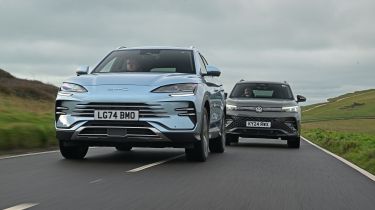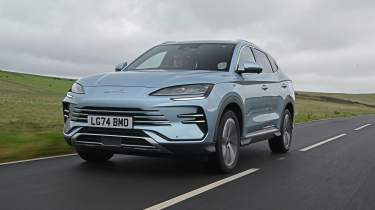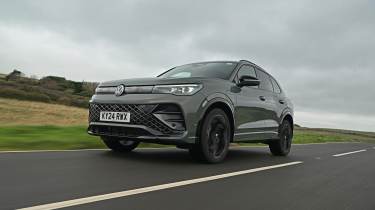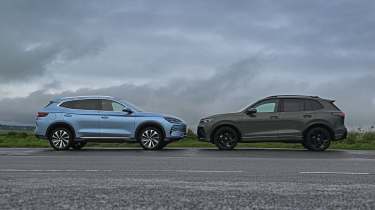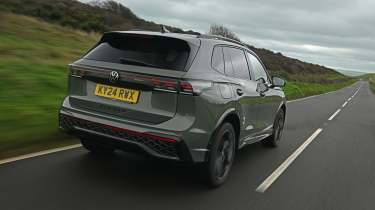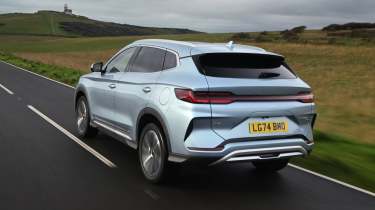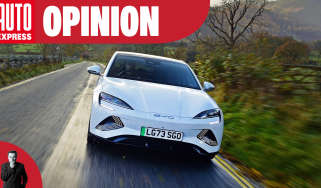Volkswagen Tiguan vs BYD Seal U: can this new arrival beat a firm favourite?
BYD is known for its EVs, but how does its first plug-in hybrid to be launched in the UK, the Seal U, stack up against VW’s Tiguan?
Chinese manufacturing giant BYD has already proved that it can build electric cars that are capable of competing with the class best. But what happens when you add a combustion engine into the mix?
The BYD Seal U is the company’s first plug-in hybrid model to be launched in the UK, and it follows a popular formula, because the tech is packed into a family-sized SUV body. A large battery should help it to travel a fair distance on electric power alone, but does the package unravel once the petrol engine kicks in? To find out, we’re pitching BYD’s newcomer against the third-generation Volkswagen Tiguan, which comes with VW’s second-generation plug-in hybrid tech.
This features a bigger battery than before, along with a more efficient petrol engine. On paper the standard Tiguan eHybrid is a close match for the Seal U in terms of performance and efficiency.
One area where they do diverge is on price, with the whole Seal U line-up undercutting even the entry-level Tiguan PHEV. Low asking prices are expected to be a selling point for many Chinese newcomers, so does the Tiguan offer enough to justify its higher tag?
BYD Seal U
| Model: | BYD Seal U DM-i Comfort |
| Price from: | £35,205 |
| Powertrain: | 1.5-litre turbo petrol plug-in hybrid, 214bhp |
| 0-62mph: | 8.9 seconds |
| Test efficiency: | 50.5mpg |
| Official range: | 78 miles |
| Annual VED: | £180 |
In China the BYD Seal U is known as the Song Plus, a car that has been on sale there since 2020 and is the company’s best-selling model. The Song Plus was facelifted in 2023, and that’s the model we get in the UK
as the Seal U DM-i, where the ‘U’ stands for utility (to differentiate this model from the Seal electric saloon), and DM-i signifies the ‘Dual Mode’ PHEV powertrain.
Used - available now

2024 BMW
5 Series Touring
23,500 milesAutomaticPetrol2.0L
Cash £29,995
2021 BMW
iX3
68,360 milesAutomaticElectric
Cash £18,936
2021 BMW
iX3
51,624 milesAutomaticElectric
Cash £21,188
2021 BMW
iX3
65,673 milesAutomaticElectric
Cash £18,952The main talking point of the Seal U is its price. Starting at around £33,000, this plug-in hybrid model undercuts even conventional combustion-engined versions of established rivals, while the kit list is similar to that of a high-spec machine costing thousands more.
Tester's notes
The Seal U is the first petrol-electric model from BYD to be launched in the UK, but it’s far from being its first combustion-engined car. When it launched in China as the Song Plus in 2020 it was petrol-only, with this PHEV version and a full EV variant arriving later. A facelift in 2023 saw the petrol model dropped, with BYD concentrating on alternatively fuelled models. Incidentally, while we don’t get the electric Seal U in the UK, it is available in Europe. BYD expects that the recently announced Sealion 7 electric SUV will be able to meet UK demand.
Volkswagen Tiguan
| Model: | Volkswagen Tiguan eHybrid Match |
| Price from: | £42,730 |
| Powertrain: | 1.5-litre turbo petrol plug-in hybrid, 201bhp |
| 0-62mph: | 8.2 seconds |
| Test efficiency: | 51.4mpg |
| Official range: | 77 miles |
| Annual VED: | £590 |
There are diesel, petrol mild-hybrid and plug-in hybrid versions of the Mk3 Volkswagen Tiguan on offer, with the latter using the firm’s latest eHybrid powertrain. This has been refined with the addition of a bigger battery and a more efficient petrol engine, and these deliver some impressive economy and electric range figures.
There have also been improvements inside when compared with the previous Tiguan, which was one of VW’s best-selling models. There’s more space and new tech, with the car featuring the company’s latest infotainment controls, so changes that were made to the Golf Mk8 make an appearance. The range comprises standard, Life, Match, Elegance, R-Line and Black Edition trims, but not every engine is available with each variant.
Tester's notes
Not many brands sell an entry-level model without a trim name, but that’s what VW has done with the base Tiguan. It’s only offered with the 128bhp 1.5 TSI engine, but it still comes with a 12.9-inch touchscreen, front and rear parking sensors and a reversing camera, while the 17-inch wheels should help it deliver the best ride of any Tiguan in the line-up.
At the other end of the range, there’s no word on the Tiguan R making a comeback, so performance SUV duties are taken up by the 2.0 TSI R-Line, with 261bhp and four-wheel drive.
Head-to-head
On the road
While the BYD steers, stops and goes, there’s an inert feeling to the controls that means you receive next to no feedback from your inputs. Bumps are heard more than felt, but the ride is also quite wallowy and uncontrolled.
The Tiguan is a lot more positive, with sharper steering that delivers better feedback and a ride that can be on the firm side in higher specs. But it has far better body control in corners.
Tech highlights
BYD’s rotating touchscreen puts in an appearance in the Seal U, but as with other cars with the set-up, once the novelty has worn off, you keep it one position – usually landscape.
The Tiguan’s 12.9-inch screen doesn’t move and isn’t as large, but it’s more user-friendly. There are clearly labelled shortcut buttons and a sharp display, while separate climate controls mean you don’t have to switch screens to use them, as in the BYD.
Price and running
Value pricing is a major attraction of the Seal U, but everyday costs are a mixed bag. If you don’t charge the battery, then official fuel economy is slightly poorer than the Tiguan’s, while a Group 50 insurance rating for top-spec cars will hit the cost of cover.
The VW’s list price means the luxury car road tax levy applies, but a smaller fuel tank means the petrol-only range is shorter than the Seal U’s.
Practicality
The Seal U is a larger car than the Tiguan, but better packaging means that the VW isn’t far behind its rival for passenger space in the back.
Boot space is actually smaller in the BYD, at 425 litres, compared with 490 litres in the Tiguan, while the latter has a lower load lip and a wider floor.
Both cars have three sets of ISOFIX child seat mounts, with two in the back and another set for the front passenger seat.
Safety
Both cars have been awarded a five-star safety rating by Euro NCAP. The BYD earned a slightly higher percentage score for adult occupant safety, while the Tiguan was marginally ahead in every other category.
There are plenty of warning beeps in both cars, but deactivating them is a longer process in the BYD because of the menu system – the Tiguan’s shortcuts take you directly to the relevant screen.
Ownership
BYD has only been selling cars in the UK for a little more than 18 months, so it’s still too early to report on how the after-sales experience is shaping up for buyers. Long warranties should offer peace of mind, though.
What is certain is that VW owners aren’t as impressed with their cars as they should be, with the marque regularly appearing at the lower end of the Driver Power ownership satisfaction survey.
Verdict
Winner: Volkswagen Tiguan
There’s plenty of appeal with the Tiguan eHybrid. A long electric-only range will be ideal for local drives, while the combustion engine will come on stream to deliver more range when you need it. It’s smooth to drive over long distances, too.
But you really need to charge the Tiguan to make the most of it, because once the battery has run down, the urban driving experience can become jerky. It’s expensive in this company, but it’s a far better car to drive and is well packaged to cope with family life.
Runner-up: BYD Seal U
Looking at what you get for your money, the Seal U makes a strong case for itself, with a long kit list and sub-£40k prices that help to keep running costs down. There’s lots of back-seat space, and the hybrid system works well to make the most of the electric drive on offer.
But the driving experience is a letdown. The soft suspension is fine when cruising, but the ponderous handling, lifeless steering and muted power delivery are clear shortcomings here. The smaller boot capacity is likely to limit its appeal as family transport, too.
Prices and specs
| BYD Seal U DM-i | Volkswagen Tiguan eHybrid | |
| Our choice | Seal U DM-i Comfort | Tiguan 1.5 TSI eHybrid Match |
| Price from/price of our choice | £33,205/£35,205 | £42,555/£42,730 |
| Powertrain and performance | ||
| Engine | 4cyl in-line/1,498cc | 4cyl in-line/1,498cc |
| Power/torque | 95bhp/122Nm | 148bhp/250Nm |
| Electric motor | 194bhp/300Nm | 113bhp/350Nm |
| System output | 214bhp/300Nm | 201bhp/350Nm |
| Transmission | CVT auto/fwd | Six-speed auto/fwd |
| 0-62mph/top speed | 8.9 seconds/105mph | 8.2 seconds/130mph |
| Fuel tank/battery capacity | 60 litres/26.6kWh | 45 litres/25.7kWh |
| MPG (WLTP comb/weighted)/range | 50.5/706.8mpg/667 miles | 51.4/703.5mpg/509 miles |
| WLTP all-electric range | 78 miles | 77 miles |
| Dimensions | ||
| Length/wheelbase | 4,775/2,765mm | 4,539/2,679mm |
| Width/height | 1,890/1,670mm | 1,842/1,658mm |
| Rear kneeroom | 700-930mm | 615-855mm |
| Rear headroom/width | 915/1,525mm | 920/1,505mm |
| Boot space (seats up/down) | 425/1,400 litres | 490/1,486 litres |
| Boot length/width | 925/955mm | 873/1,000mm |
| Boot lip height | 780mm | 720mm |
| Kerbweight/payload/towing weight | 1,995/410kg/N/A | 1,866/544/1,800kg |
| Turning circle | 11.0 metres | 11.7 metres |
| Costs/ownership | ||
| Residual value (after 3yrs/36,000 miles) | £17,997 | £23,618 |
| Depreciation | 54.20% | 55.50% |
| Insurance group/quote/VED | 32/£1,660/£180 | 27/£706/£590 |
| Three-year service cost | TBC | £492 (2 services) |
| Annual tax liability standard/higher rate | £352/£703 | £427/£854 |
| Annual fuel cost (10k miles) | £1,478 | £1,452 |
| Basic warranty (miles)/recovery | 6yrs (93,750)/4yrs | 3yrs (60,000)/1yr |
| Driver Power manufacturer position | N/A | 29th |
| NCAP Adult/child/ped./assist/stars | 90/86/83/77/5 (2023) | 83/88/84/78/5 (2024) |
| Equipment | ||
| Metallic paint/wheel size | Yes/19 inches | Yes/18 inches |
| Parking sensors/camera | Front & rear/360 degrees | Front & rear/rear |
| Spare wheel/Isofix points | Repair kit/three | Repair kit/three |
| Keyless entry & go/powered tailgate | Yes/yes | No/no |
| Leather/heated seats | Synthetic/ventilated | £2,855/£840 pack |
| Screen size/digital dashboard | 15.6/12.3 inches | 12.9/10.25 inches |
| Climate control/panoramic sunroof | Two-zone/yes | Three-zone/£1,385 |
| USBs/wireless charging | Four/two | Four/£1,130 pack |
| Wireless CarPlay/Android Auto | Yes/yes | Yes/yes |
| Blind-spot warning/head-up display | Yes/yes | Yes/£625 |
| Adaptive cruise/lane-keep assist | Yes/yes | Yes/yes |

